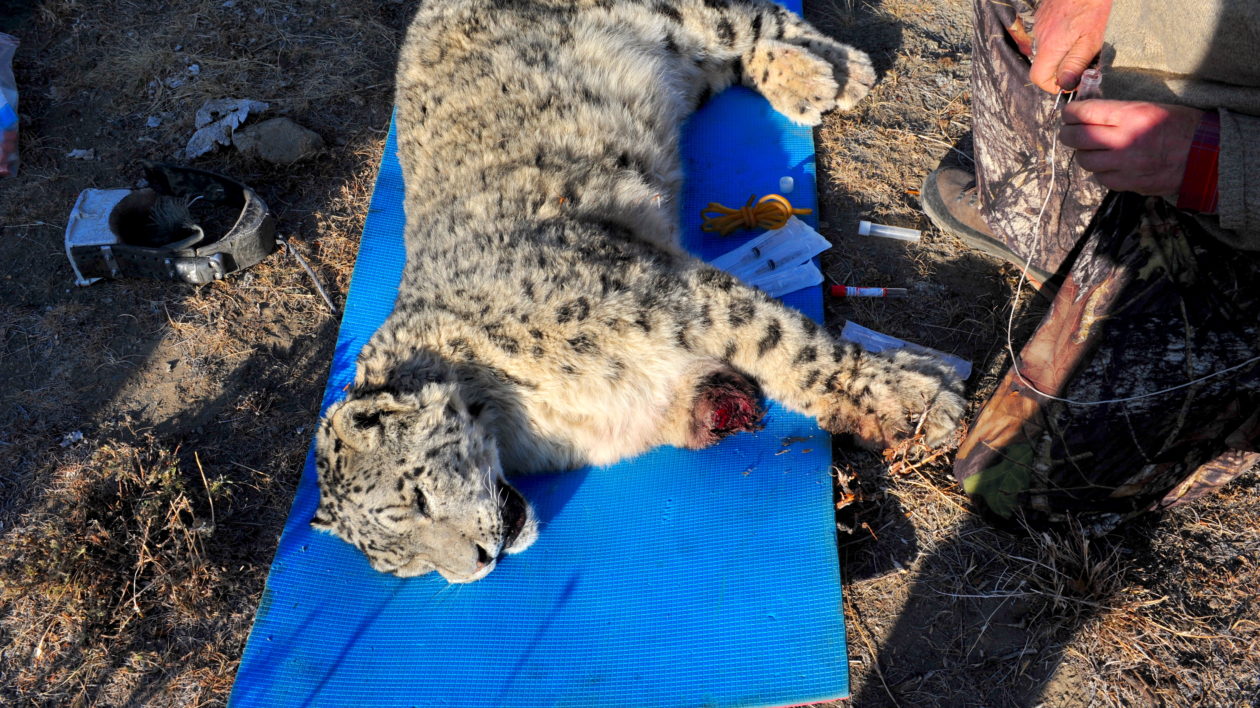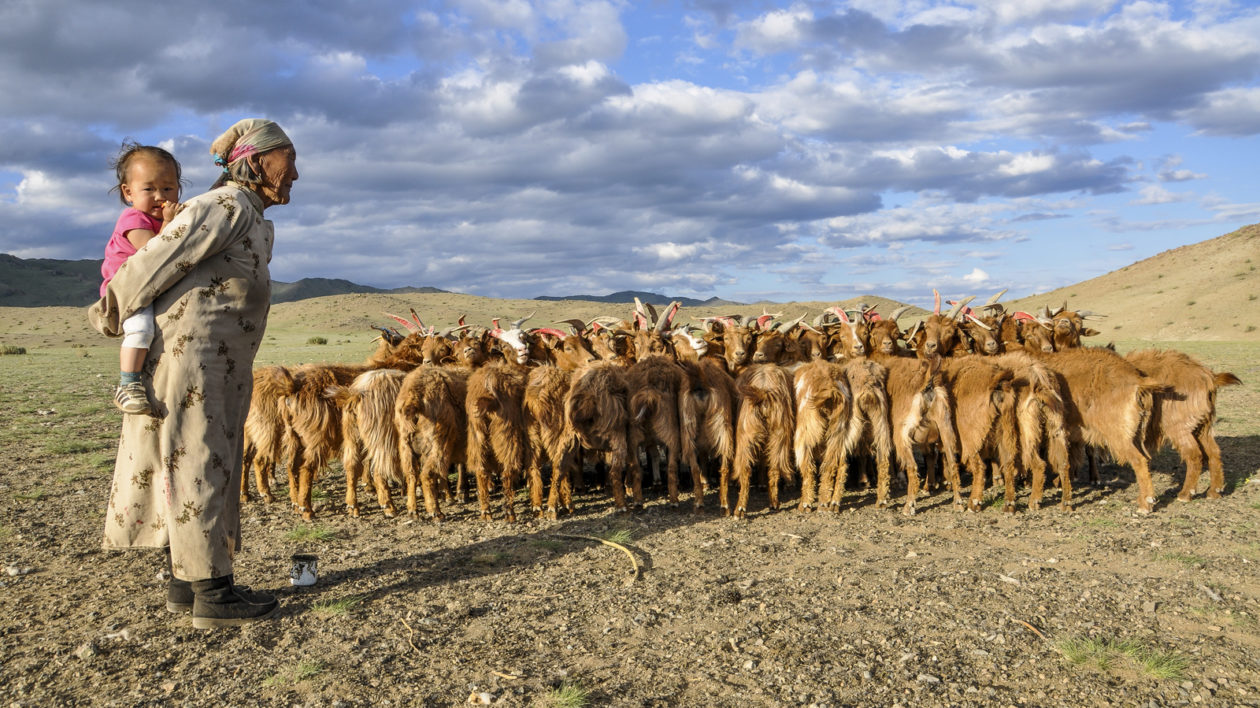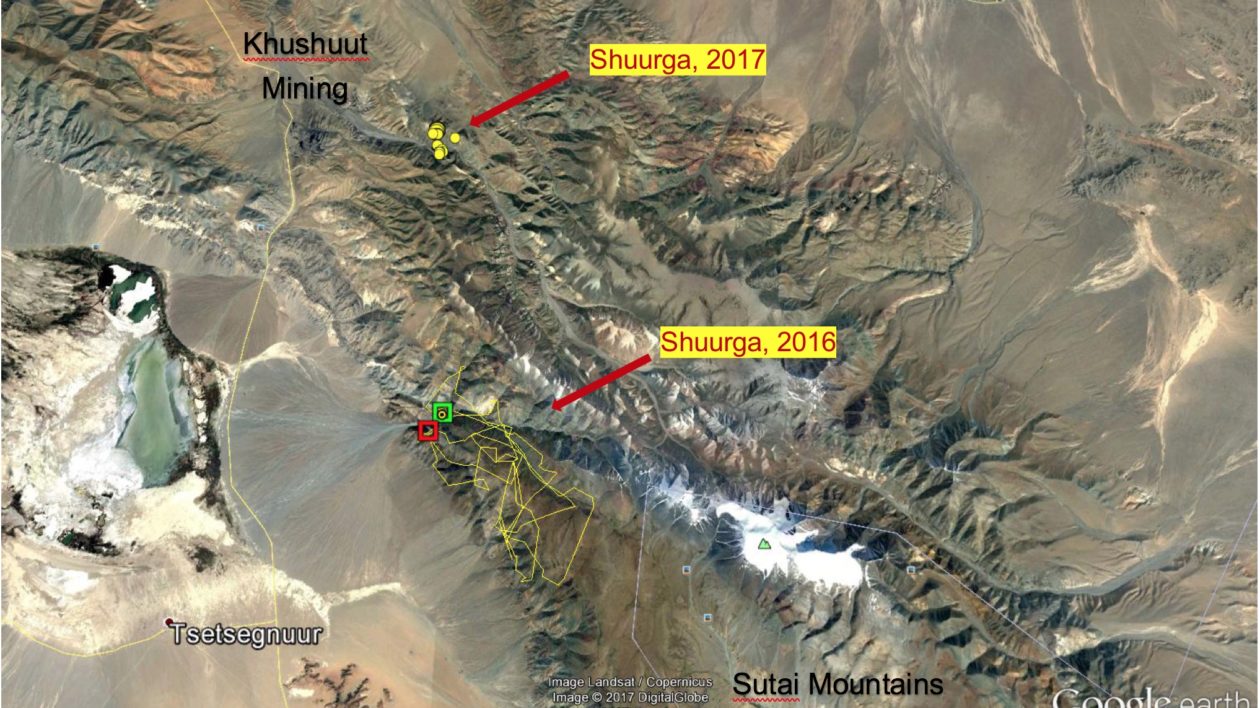Something was wrong with the snow leopard. The scientists watched as the tranquilizers kicked in and the cat sank down to the bottom of the cage. Moving closer, they realized that the young male was injured: his front-right leg was severed below the shoulder.
Here in western Mongolia’s Sutai Mountains, Nature Conservancy scientists are collaring snow leopards to better understand when and how they interact with local herders’ goats and sheep. These data will help design grazing plans that keep both leopards and livestock safe.
Tracking the Storm
Known as “the ghosts of the mountains,” snow leopards are found throughout Asia’s high mountain ranges. One of the most elusive big cats on earth, they are threatened by habitat degradation, poaching, and a decline in prey species due to competition with livestock.
Mongolia has about 1,000 of the world’s remaining leopards, clustered in the country’s south and west. In the Bumbat and Sutai Mountains, The Nature Conservancy is working with the Mongolian Academy of Sciences and Moscow State University to protect leopards and herders’ livestock. But to do so, they must first catch and collar leopards.
The scientists recognized this particular cat; in October 2016, they captured him in Khavtsgait Valley, about 30 kilometers to the southeast, and fitted him with a satellite collar. Caught amid a thunderstorm, they named him Shuurga, which means storm in Mongolian. But after just six months the signal from his collar went dark.
“Somehow he smashed his collar, and after March 2017 we didn’t get any signal,” says Bayarjargal Yunden, director of science for the Conservancy’s Mongolia program. And somewhere between then and now, he also lost a leg.

The team worked quickly. Laying Shuurga down gently on a mat, they fitted a new collar around his neck and gathered blood and genetic samples. The short stump that remained of his leg was still bloody and ragged, the wound was likely less than 2 months old, and bullet wounds grazed his back.
Shuurga is one of two collared leopards in the study; the second is a female leopard also collared in October 2016. The collars around their necks transmit a GPS location every hour, creating a detailed map of the leopards’ movements. “The data from these collars will help us understand where there are key points of interaction with livestock,” says Eddie Game, the Conservancy’s lead scientist for the Asia-Pacific region.
The Nature Conservancy is working with Mongolian herders to implement sustainable grazing practices. Yunden says that Mongolian herders traditionally moved their livestock each season, based on observation of pasture condition. They also reserved certain areas for winter pasture, keeping them ungrazed during the rest of the year to ensure an adequate winter food supply.
But the system broke down in the 1990s as Mongolia transitioned away from socialism. Yunden says the government dismantled the state herding collectives and privatized livestock ownership. Herders seeking more income increased their flocks, and the country’s livestock population jumped from 22 million in 1990 to 66.2 million by 2017.
“That resulted in overgrazing, land degradation and desertification, struggles between herders for grazing areas, and conflicts between livestock and wild animals,” explains Yunden.

Today, as part of a government conservation incentive program, communities can obtain exclusive grazing rights to an area of land if they create and enforce a grazing management plan.
“We’d like to incorporate snow leopards into these plans at a landscape scale,” says Game. “Ideally, we could identify the risky times for interaction, and work with the communities to design the grazing plan to minimize leopard-livestock interactions.”
Game says that conservationists don’t have a good understanding of how local leopards’ territories overlap with grazing areas, hence the need to gather data on the cats’ movements. The research team is also collaring two ibex, a common prey species for snow leopards, which will allow them to compare grazing areas for both livestock and the leopard’s wild prey.
And in 2015, Game and Yunden deployed more than 40 camera traps throughout the two mountain ranges to get a more accurate population assessment for the area. “It’s important to know that there’s a healthy population here,” says Game, “because it adds to the overall population assessment in Mongolia and confirms this as an important site.”
This type of integrated, community-based conservation is critical for snow leopard survival, because the species has large home ranges that are difficult to protect. Research shows that of the 170 protected areas in the snow leopard’s global range, 40 percent are smaller than the home range of a single adult male.

Finding Solutions for Human-leopard Conflict
As Shuurga’s injuries attest, human conflict is still a major challenge for snow leopard conservation. Game suspects that the cat caught his leg in an illegal marmot trap, and then either severed his limb in the struggle to get free, or suffered such a severe injury that the lower leg fell off.
The bullet marks are another mystery.
Since October, Shuurga’s second collar is working well, sending back detailed data on the cat’s movements. “There’s a mining site in the area, and Shuurga usually stays very close to the town where the workers live,” says Yunden. (The second cat, a 5-year old female, occupies a territory farther up the mountain.)
“We think that Shuurga’s injury makes it really hard for him to capture wild animals,” says Yunden, “so maybe it’s easier for him to catch livestock.” The bullet wounds could be the result of a herder defending their flock.

Retribution killing for livestock loss is another significant threat for snow leopards, but Game says that previous research indicates that levels of human-leopard conflict are comparatively low in Mongolia, where people tend to have larger herds. And research shows that leopards prefer natural prey species, even in areas where that prey is outnumbered by livestock.
“But at the same time, the snow leopard populations just isn’t that big,” says Game. The global population numbers between 7,500 and 8,000 individuals, about 1,000 of which are spread out across Mongolia. “With such a small population, you don’t have to lose that many leopards before it starts to make an impact,” he says, “especially if they’re isolated.”
Lack of awareness about leopard behavior is another problem. In addition to incorporating leopards into grazing plans, the Conservancy is working with the Snow Leopard Trust to help educate herders about leopards, in the hopes of reducing these killings.
“We need to work with herders to identify solutions,” says Yunden. “Without them it’s just not possible to protect these animals.”



I want to know if his leg was treated & given antibiotics. Why can’t he go to a sanctuary? You put on a new collar, but didn’t treat his leg? What is the point? He is going to die from infection & maybe starvation. Why wasn’t he given treatment? You call a collar humane but leave his leg torn apart? Where are your priorities?
Hi Janeth, thanks for your comment… please see a reply from Eddie Game further down in the thread.
Wouldn’t it be better to capture him and retire him to a sanctuary, rather than let him starve?
My first thought about this article was, as others posted, was concern about this animal’s wound. Surely he wasn’t let loose with that raw untreated amputation still open! But nothing was said about his treatment. I hope that the poor animal had the wound closed and a shot of antibiotics given.
Hi Jennifer, thanks for your comment… please see a reply from Eddie Game further down in the thread.
Thank you to you and your team for all that you do to save these majestic animals. We must all take a stand to save and protect them by donating, signing petitions and buying your products sold to help defray costs. It makes me really sad what happened to Shuurga and I hope and pray that even though he has been seriously injured he recovers and lives to a ripe old age.
Since Shuurga is “differently abled” (PC for handicapped), how can you generalize information from his hunting habits to a more general population?
I understand that you probably could not intervene to treat the animal because it would violate the experimental protocol . If that is what happened, I understand but I don’t like it one bit,
Humans are a sorry excuse of a species, and yes I am one of them. We think we’re better than all other animals, but we’re not, we’re much, much worse. Reading this sad story about this magnificent animal made me cry for him. He SHOULDN’T have to suffer because of our stupidity. No animal should. Also, what exactly did these people do to ease his pain, make sure the wound didn’t get infected, etc. All they did was collar him? Hmmm, not thinking very highly of them.
I read Maggie Frazier’s comments, and I agree with her 100% about our precious wild horses. Not only our precious wild horses, but the WOLVES, BEARS, BISON, etc., etc., etc. The USDA Wildlife Services is one of the most vile and disgusting federal programs in our nation! They MURDER millions of animals per year primarily to help special interest groups. I thoroughly despise them and what they stand for and should be obliterated. The name for our species should be inhumanity for all the horrors we commit upon other species.
In this day and age of “tiny” electronics why can we not find something smaller to put on the wild animals. I am sure it is very uncomfortable for them with simply a collar much less one with a large electronic tracking device.
I pray we can save these beautiful cats and all animals.
Because this leopard is handicapped why don’t you let him spend his remaining years in the comfort and safety of a good zoo?
So has the three legged snow leopard survived? Can he feed and fend for himself?
Makes me sad that humans, regardless of their excuses, kill our wildlife so recklessly and without remorse. Knowing that these beautiful creatures are on the verge of extinction. It’s a shame our wildlife has been displaced by humans and building growth – they have less and less space to live and hunt as God had intended. Now they fear daily for their lives and the lives of their family – God willing they have them.
Amazing work. Thank you!
Great story
I finished reading “American Wolf” recently & learned about tagging & following the wolf & elk population in an effort to save wolves & reduce loss by hunters & ranchers. I am so happy to read that there is a similar program for these amazing snow leopards, who need to be preserved. Cooperation with humans is essential with dwindling habitat! Thank you for the terrific reporting.
RE: Shuurga- Injured Snow Leopard
He was caught with one leg GONE and the stump still bloody. He was fitted with a new sattelite collar..but no mention of any treatment for his severe wound…and then released to “Hunt” for himself??…kind of cruel..no??
How is he going to survive with such a severe wound?
Hi John, thanks for your comment… please see a reply from Eddie Game further down in the thread.
I was amazed how much I learned from your letter and the video. Please keep them coming as I share what I have learned. Thank you!